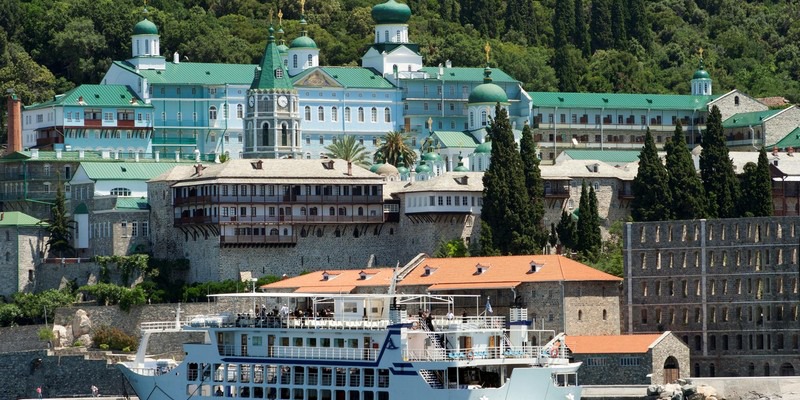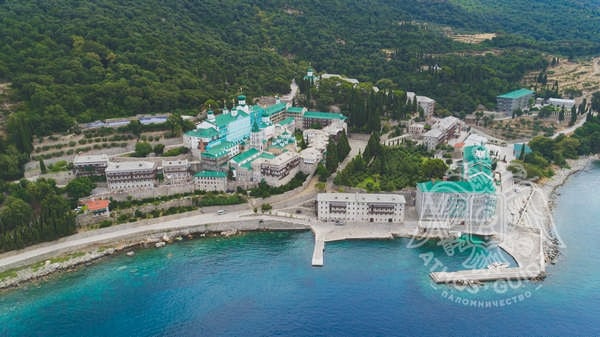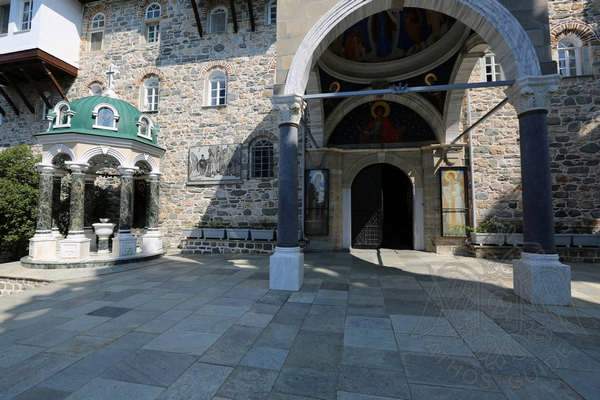History and present days
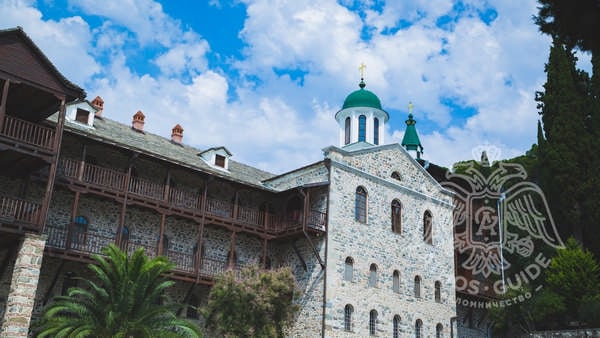
The Monastery of Saint Panteleimon, also known as the Russian Monastery of Mount Athos, was moved to its present location during the early 19th century.
The peculiarity of its architectural structures, that follow the Russian style with bulbous domes, is added to the fact that the roofs of the churches are not constructed with the usual material but are covered with copper sheets that oxidize and turn green.
The gigantic scale of the buildings is impressive. At the beginning of the 20th century, when the monastery was at its peak, more than 2,000 monks used to live there. The roofless multilevel building on the beach was a hospital. Additionally, a great number of monks who lived in cells and isolated hermitages were coming to the shores in order to collect the alms distributed by the Russian Monastery. Saint Silouan the Athonite lived his monastic life in the building located next to the hospital.
The first monastery we pass by is Saint Panteleimon of the Russians. A monastery? Probably more of a secular spa town. I think I see the Swiss Montreux transferred to Mount Athos. Buildings with seven levels, chalets, pavillons, domes like those of a cosmopolitan hotel. The propaganda of the Tsar wanted to astonish the world and succeeded in driving God away.
Them. Athanasiadis-Novas, 1964.
Despite the resemblance to a secular destination, the passage reflects a great conflict and the latent Cold War climate of that time.
The floor plan of the monastery has a quadrilateral shape. The multilevel north wing is particularly imposing. The original building core was much smaller and formed a rectangle around the katholikon. Its expansion led to the enlargement of its garden and the incorporation of the high-rise buildings that had been built on the beach. Plans for a new, larger katholikon have also been made but political developments in Russia prevented their realisation.
In 1143, the Monastery of Xylourgos [today's Skete of Bogoroditsa] was granted to Serbian monks from Rausio [today's Kotor, in Montenegro] by the decision of the Protos. After 25 years, the Serbian monks were multiplied and in 1169 the Monastery of Thessalonikeos was granted to them. They moved to the new monastic structure and kept the Monastery of Xylurgos as a skete. The monastery always enjoyed the protection of the Serbian rulers. Prince Ratko, son of Crown Prince Stefan Nemanja, became a monk there and received the name Savvas. After the fall of the Serbian kingdom (1509) Angelina, the widow of Crown Prince Stephen, became a nun and asked the Russian Grand Prince Basil Jovanovich (1505-33) to take the Monastery of Thessalonikeos under his protection. From then on, there was a great bond between the monastery and Russia, while the number of monks increased substantially. Especially after the expulsion of the Mongols from Russia (1497) more and more people were coming to the monastic community. In the third Typikon of Mount Athos, the monastery occupied the 5th place of the hierarchy. In the middle of the 16th century, it faced such serious financial problems that it was forced to close. The Russian traveler V. G. Barsky reports that on his first trip (1725/6) he found only two Greek monks and two Bulgarians, while on his second trip (1744) he found none. The monastery fell again into the hands of Greeks, who in 1765, under the Patriarch Samuel I, decided to bring the monastery to its present location, where the arsanas and the seaside tower of the Monastery of Thessalonikeos were located, and where, in 1667, the Bishop Christophoros of Ierissos had built a chapel dedicated to the Resurrection. Generous donations from a series of rulers of Moldavia, coming from the Kallimachi family, allowed the monastery to regain its financial prosperity and expand.
 Пантелеймона.jpg)
Their contribution was so fundamental that in 1806 the monastery was called an "authentic commune of Kallimachis", while the description of it as a "Russian monastery", which had been given because of the ethnic origin of its monks, was abolished.
The monastery was recognized as a cenobitic communtiy (1803) by a sigil of the patriarch Kallinikos V. Τhe first abbot was the Xenophonite monk Savvas the Peloponnesian. With the assistance of Scarlatos Kallimachis, many new buildings were built, as well as the katholikon, which was inaugurated in 1805 by the Ecumenical Patriarch Gregory V. The last Greek abbot was the Hieromonk Gerasimos, who was elected in 1832. The poverty in which the few monks of the monastery found themselves made them accept (1838) and bring in the monastery Russian monks who were living in the cells of Kapsala. The number of Russians increased rapidly. In 1869 there were already 250-300, compared to 190 Greeks. The first Russian abbot, Archimandrite Makarios, was elected in 1875. This increased a conflict that came to the Ecumenical Patriarchate. Despite the disagreement, the Patriarchate recognized the dominion of the Russians and named the monastery "Russian Commune of Saint Panteleimon". The Greek monks moved to other monasteries in Athos, while in some cases they were forcibly removed by military forces. Within thirty years the number of Russians reached the 2,000 monks. The number of additional buildings reflects the needs of this large population. The monastery owned a steamboat, a sailboat, barges and fire pumps. It also had a complete and renowned photographic laboratory and maintained a correspondence office, which was handled by 80-100 monks.
Once in Saint Panteleimon the Russian, on the eve of the first of October, when an overnight vigil is held in honor of the Holy Protection of the Most Holy Theotokos, Father Anthimos, having just arrived at the monastery, almost passed away. When he met a monk of the brotherhood that he knew, he said to him: “I was near the Zograf Monastery, in the desert, praying upright on a stone. At the time of prayer, I saw the Mother of God descending from Heaven to your monastery. As I was full of joy in Her apparition, I hastened to come and find Her here, so that She might cover me with Her mantle, a sinner, together with the servants who honor Her. However, just as I set out to run here, suddenly a snake appeared and bit me hard on the leg. I understood that this obstacle was from the envy of devil, and I paid no attention to the bite, but I was in a hurry to reach your monastery.” The brother looked at his leg. Indeed, the wound from the bite was severe. The Elder's great love for God had made him now insensitive to physical suffering.
Venerable Father Paisios the Athonite, The Holy Fathers and Athonites, 1980
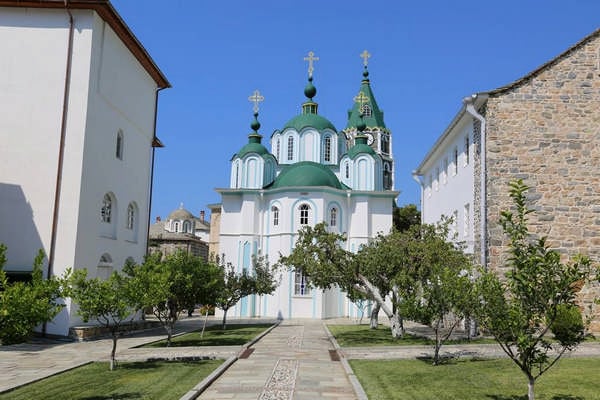
At the beginning of the 20th century, the doctrine of "imiaslavie", the belief that the very spelling of Christ's name sanctifies the one who pronounces it, spread especially among the Russian monks of the cells. The Holy Community condemned immediately the doctrine as a heresy. The general opinion of the monks was that this theory surrenders to a certain detail and loses the real meaning of the Christian faith. However, the number of monks who believed in “imiaslavie” increased in the Russian monastery. They refused to honor the Tsar, so that he decided to send (1913) a destroyer, which blocked the monastery from the sea and probably even bombed it. Military forces arrested the monks, some of whom were killed. They were exiled to the Caucasus, where shortly afterwards most of them were executed by the Bolsheviks. The Tsar's action was an example of strong diplomacy, at a time when the international status of Mount Athos had not yet been consolidated after its liberation from the ottoman rule. This act, however, has in no way affected the monks of the monastery during the next years, since they still acknowledge the Tsar, they refer to him as a saint and they honor him. The monastery followed a course of decline after the October Revolution (1917). It almost reached the brink of desolation. In 1968 it suffered a huge fire that caused great damage. After the political upheavals in Russia (1989), the number of new monks, the majority of whom had a Ukrainian origin, increased.
The monastery was home to the holy new martyrs Nikitas († 1810, Serres) and Paul († 1818, Tripoli). Saint Silouan the Athonite also lived there. Saint Anthimos, the Fool for Christ from Sofia, Bulgaria († 1867) often visited the church and passed away in the monastery.
